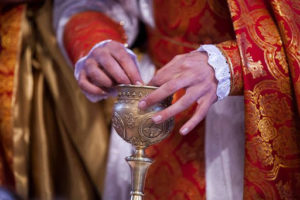 The Divine Liturgy is divided into four parts, namely, The Preparation, Synaxis, Soorp Badarak and Final Blessing and Dismissal. Each of the four parts depict the significant events in the life of Jesus Christ.
The Divine Liturgy is divided into four parts, namely, The Preparation, Synaxis, Soorp Badarak and Final Blessing and Dismissal. Each of the four parts depict the significant events in the life of Jesus Christ.
Part I – The Preparation
This is the first part of the Badarak. In this part, the celebrant prepares himself to perform the duties of the Badarak and also prepares the elements of communion. In order to be worthy of the honor of performing the Holy Sacrifice in the name of God, the celebrant first engages in Vesting.
When the celebrant is vesting, he asks God’s help and blessing with each article of clothing that he wears. The celebrant performs this act in private with the help of a deacon. After the completion of vesting, the celebrant makes his entry into the Church both as a king and a servant.
After the celebrant enters the chancel, he proceeds to the Bema and washes his hands with the help of a deacon. By this act, the celebrant signifies the cleansing of his soul from his sins before he approaches the divine mystery of the Holy Sacrifice.
With the act of vesting and purification, the celebrant is prepared to gain the divine right to perform the Badarak. Thus, behind the closed curtain the celebrant enters into the divine presence of God and begins to perform his duties.
Behind the closed curtain, the celebrant offers to God the Eucharistic elements which are Bread and Wine. This offering symbolizes both Christ’s Immaculate Conception and His Vicarious Crucifixion. The Church, in this case, symbolizes the mystical body of Christ receiving its flesh (Bread and Wine) which will become the Body and Blood of Christ through the Holy Spirit.
The celebrant blesses the Bread (Neshkhar) and Wine (Keene) and offers them to God.
Part II –Synaxis
This part of our Church Service can be compared to Protestant services. This is the teaching and learning portion of the service, intended in early days as an instructive service to potential members of the church.
The procession, or Tapor, around the church symbolizes the teaching ministry of Jesus Christ. The church is censed by the celebrant which symbolizes the visible form of our invisible prayers and an offering for the atonement of our sins.
The Lesser Entrance refers to the procession of the Holy Bible behind the Altar and its presentation to the celebrant.
The Lections (lessons from the Old Testament and the Epistles of the New Testament) the deacon reads from the chancel while the Gospel is read on the Altar.
The Creed is the proclamation of faith by all the congregation. The Nicene Creed, used in our church, forms the basis of Christian belief.
Part III –Soorp Badarak or Eucharist
This is the longest and most important part of the Badarak. Everything that occurs prior to this time prepares the way for this most divine miracle. To better understand Part III, one must be familiar with the events of the Last Supper which can be found in Matthew 26:26-28, Mark 14:22-24, Luke 22:19-20.
We know that, at the Last Supper, Christ did four things: namely, He took bread (which is called the offertory in our service), gave thanks (Eucharist), broke the bread (Instinction and Fraction), and gave it to His disciples (Communion). These four events are dramatized in our Church Service.
We remember that the Lesser Entrance refers to the procession of the Holy Gospel behind the Altar. The Great Entrance refers to the procession of the Chalice behind the Altar and its presentation to the celebrant. This act represents Christ’s redemptive work. In other words, Christ offers His Body and Blood (symbolized by Bread and Wine) to His people as atonement for their sins.
The Altar in our Church symbolizes the Cross upon which Christ was crucified.
The celebrant lifts up the Neshkhar (wafer) and then the Chalice and presents them as an everlasting symbol of the Body and Blood of Christ.
When the gifts are presented to the celebrant, the gifts are still Bread and Wine, representing the Body and Blood of Christ. It is at the symbolic moment of Jesus Christ’s death on the cross that the Holy Spirit descends and enters the gifts and transforms them into the Body and Blood of Jesus Christ. This event occurs when the celebrant blesses the elements nine (9) times while each time the Chalice is censed by the deacon.
The celebrant, who speaks for Christ, then offers the communion to the congregation. Before the communion, a confession is said by the participants. The communion is administered by the celebrant individually to he participants. Communion is the final act of the Holy Sacrifice. It is the sacramental union of the believer with the Lord Jesus Christ through the help of the Holy Spirit.
Part IV – Final Blessing and Dismissal
This part is very brief and it consists of the celebrant’s blessings, a reading from the Gospel and Hokehankist (Requiem Service) if it is requested or permissible. During the Five Daghavars (Major Feasts) of the Armenian Church, Hokehankist cannot be performed. The Daghavars are the following feast days: Christmas Eve and Christmas or Dzunoont, Easter Eve and Easter or Zadeeg, Transfiguration or Vartavar of Jesus, Assumption or Asdvadzadzin of St. Mary and Exaltation or Khachveratz of the Holy Cross.
Upon the Last Gospel, John 1:1-14, rests the theological foundation of the Christian Church and upon the phrase, “the Word was made flesh,” lies the belief of the incarnation of Christ through the act of the Holy Spirit. At this point, the faithful should realize that the Word of God wells among them through the Holy Spirit, God’s moving and motivating power in our lives.
Following the Gospel, the celebrant dismisses the congregation with the following prayer: Be ye blessed by the grace of the Holy Ghost. Go in peace, And the Lord Jesus Christ Be with ye all, Amen.
At the end of the service the faithful, full of spiritual nourishment and guidance, must shape his daily life according to the precept of the Gospel that he may be worthy again to participate in the Holy Sacrifice or the Soorp Badarak of the Lord.
The Mahs, or the Antidoron, which is distributed to the faithful after attending the Badarak, is not Communion. It is a blessed bread taken from the same substance from which the wafer is prepared and serves as a symbol of participation in the offertory or oblation. Mahs means share, and by having the Mahs the believers demonstrate their sharing with the rest of the congregation in their devotional life.

